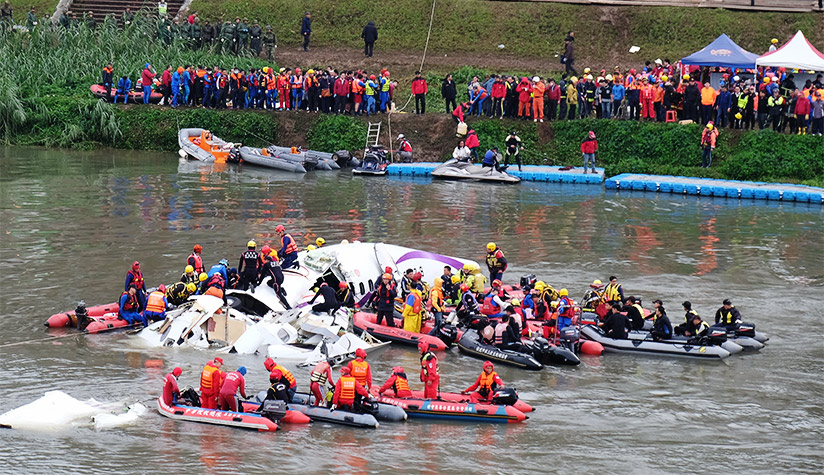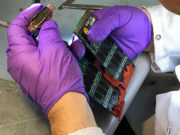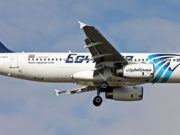
The image of an ATR 72 crossing an overpass in knife-edge flight, its left wing tip grazing a taxicab, appeared on global media, prompting widespread speculation about the cause of the upset. Loss of control following a propulsion system malfunction was a plausible guess due to its frequency in accident causation.1
And that is, indeed, what happened, according to the formal investigation conducted by the Aviation Safety Council of Taiwan (ASC). However, the instigating factor likely came as a surprise to most aviation safety specialists due to its rarity: The ASC found that the accident was prompted by a spurious activation of the propeller autofeather system.
Moreover, the council’s final report indicated that even before the accident occurred the morning of Feb. 4, 2015, there was evidence that the system could fail. It had happened twice (without further mishap) due to intermittent signal discontinuities related to aging of the system, and the engine manufacturer had issued service instructions to address the problem.
The ASC found that the airline, TransAsia Airways, had not adequately informed its flight crews of the problem and had not issued clear instructions that a takeoff must be rejected if there are any signs that the autofeather system is not working properly.
The ASC’s report said that the accident pilots had noticed a system anomaly but had continued the takeoff. And when the right propeller feathered on takeoff, they did not act according to their training in identifying the cause of the loss of thrust and handling it appropriately.
“Following the uncommanded autofeather of engine number 2, the flight crew failed to perform the documented failure identification procedure before executing any actions,” the report said. “That resulted in the pilot flying’s confusion regarding the identification and nature of the actual propulsion system malfunction.”
In his confusion, the pilot reduced power on the operative engine and then shut it down. The report said that inappropriate flight control inputs following the total loss of power led to a stall and loss of control. The aircraft flew over part of the city before it struck the overpass and descended into the Keelung River.
Thirty-nine passengers, one cabin crewmember and the three flight crewmembers were killed; 132 passengers and one cabin crewmember were seriously injured; and one passenger sustained minor injuries. The taxicab driver also was seriously injured, and his passenger received minor injuries.
‘Performance Weaknesses’
The ATR 72-600 was being operated by TransAsia Airways on the second of two round-trip flights between Taipei and Kinmen, Taiwan. The first flight departed from Songshan Airport at 0744 local time and returned at 1012.

The flight crew comprised two captains and a first officer who occupied the cockpit observer’s seat.
The pilot flying (PF), 42, had served as an air force pilot before being employed by a Taiwanese airline as an Airbus A330 pilot trainee in September 2009. However, he did not pass the training.
“He could not meet the airline’s pilot performance standards and requirements despite additional remedial training,” the report said. “The flight training department subsequently decided to discontinue his training on 30 March 2010.”
Deficiencies recorded in the department’s training records included an inability to handle multiple tasks, insufficient situational awareness and lack of confidence and resistance to stress, the report said.
The PF joined TransAsia Airways in August 2010, completed ATR 72-500 training and initially served as a first officer in type. He upgraded as captain in August 2014 and then completed differences training as an ATR 72-600 captain in November 2014.
The report noted that the PF failed his first check ride in an ATR 72-500 simulator. Among the items performed unsatisfactorily were handling a hydraulic system malfunction and conducting a single-engine go-around. He received additional simulator training and passed the subsequent check ride by the airline’s chief pilot.
The instructor who had performed the final evaluation of the PF during ATR 72-600 differences training reported that he “may need extra training” in handling engine failures on takeoff and single-engine go-arounds. These procedures were assessed during his subsequent check ride, and the PF’s overall performance was categorized as “satisfactory” (a common term used to denote that a pilot meets company performance standards).
These findings led the ASC to conclude that the airline “did not effectively address the evident and imminent flight safety risk that [the PF] presented.”
“[The PF’s] performance during the occurrence was consistent with the performance weaknesses noted during his training, including his continued difficulties in handling emergency and/or abnormal situations, including engine flameout at takeoff and single-engine operations,” the report said.
At the time of the accident, the PF had 4,914 flight hours, including 3,151 hours in the ATR 72-500 and about 250 hours in the 600.
The pilot monitoring (PM), 45, was employed by TransAsia Airways in June 2006 and served as an ATR 72-500 first officer before being upgraded as captain in the 500 and then the 600. He had 6,922 flight hours, including 6,482 hours in ATR 72s.
The first officer, 63, flew as a McDonnell Douglas MD-82 captain before joining TransAsia as an ATR 72-500 first officer in October 2008. He was receiving differences training in the 600 when the accident occurred. He had 16,121 flight hours, including 7,911 hours in MD-82s and 5,314 hours in ATR 72s.
‘Undiscovered Issues’
The accident aircraft, manufactured in 2014, had accumulated 1,627 flight hours and 2,356 cycles. The left Pratt & Whitney Canada PW127M engine was built in 2014 and had accumulated 829 operating hours and 829 cycles since its installation on the aircraft. The right engine, built in 2013, had 1,627 hours and 2,356 cycles.
The aircraft’s autofeather units (AFUs) were components of the PW127M’s automatic takeoff power control system (ATPCS), which was designed to feather a propeller when engine torque decreases below a specific value and to increase power on the operating engine.
Three conditions must be met for the autofeather system to be armed for takeoff: The “ARM” pushbutton on the cockpit center console must be selected (pressed in); both engines must be producing more than 46 percent torque; and both power levers must be advanced beyond a lever angle of 49 degrees. The “ARM” pushbutton illuminates when all three conditions are met.
Two incidents involving malfunctions of the ATPCS had occurred in the five years preceding the accident. In one case, a faulty connection between two components of the system caused right-engine torque to vary between 20 percent and 100 percent during takeoff. The other incident occurred during cruise flight, when the propeller on the left engine feathered due to a system defect. Both aircraft, ATR 72-500s, were landed without further incident.
The engine manufacturer subsequently issued a service bulletin advising that aging of electrical connectors can cause signal discontinuities requiring inspections and repair of AFUs before they reached 12,000 hours time in service.
“The two AFUs [in the accident aircraft] had accumulated time far below the manufacturer’s inspection recommendation,” the report said. “This suggested that the causes of intermittent continuity failure of the AFU may not only be related to aging, but also to other previously undiscovered issues.”
Unheeded Warning
Visual meteorological conditions prevailed at Songshan Airport when the flight crew began the takeoff from Runway 10 at 1051 local time. Early in the takeoff roll, the PM announced that the ATPCS was not armed, as indicated when the “ARM” pushbutton did not illuminate when power was increased.
Investigators later determined that age-induced faults in soldering joints inside the no. 2 AFU likely caused intermittent discontinuities in the signals between the AFU and the ATPCS torque sensor. The signal discontinuities initially caused the indication that the ATPCS was not armed for takeoff and later caused the needless autofeathering of the right propeller.
According to undocumented company policy, the appropriate response to the indication that the ATPCS was not armed was to reject the takeoff. However, “TransAsia Airways did not have a clear, documented company policy with associated instructions, procedures and notices to crew for ATR72-600 operations communicating the requirement to reject the takeoff if the ATPCS did not arm.”
In response to the PM’s announcement that the ATPCS was not armed, the PF said, “Really? OK, continue to take off.” The PM concurred, saying, “We will continue.”
A few seconds later, the “ARM” pushbutton illuminated, and the PM said, “Oh, there it is. ATPCS armed.” The ATR 72 became airborne shortly thereafter, and the PF engaged the autopilot.
‘Premature Action’
The aircraft was in a climbing right turn at 1,200 ft when the propellers on the right (no. 2) engine began to feather. The master warning system activated, and the procedure for responding to an engine failure on takeoff appeared on the cockpit’s engine warning display.
The PM was beginning the procedure, which initially calls for identifying the failed engine, when the PF disengaged the autopilot and said, “I will pull back engine one throttle.”
“Wait a second,” the PM said. “Cross check.” However, the PF had already retarded the left-engine power lever, reducing torque from the ATPCS-commanded 104 percent to 22 percent.
“The flight crew failed to perform the appropriate failure identification procedure before the PF reduced power on the operative engine,” the report said. “This premature action led to confusion in the cockpit.”
The aircraft was climbing through 1,485 ft at 106 kt when the PM told the PF to “watch the speed.” Indicated airspeed had decreased to 101 kt (about 2 kt above VMCA, the minimum control speed with one engine inoperative).
The ATR 72 was at 1,630 ft, the highest altitude it would attain, at 102 kt when aural and visual stall-warnings activated. The loss of engine power and “inappropriate flight control inputs by the PF” had brought the aircraft close to stalling, the report said. “The crew did not respond to the stall warnings in a timely and effective manner.”
The confusion among the pilots was evident when the PF told the PM to shut down the left engine and feather the propeller. Shortly thereafter, the aural and visual stall warnings activated again, followed by the stick-shakers.
Recorded flight data indicated that the left engine’s condition lever was in the shut-off position as the aircraft descended through 1,165 ft at 110 kt.
‘Both Sides Lost”
The flight crew tried twice, unsuccessfully, to re-engage the autopilot. The stick-shakers and stick-pushers activated several times as the ATR 72 continued in a descending right turn.
A few seconds before impact, the observer remarked, “How come it becomes like this?”
The PM said, “Both sides … lost.”
The aircraft was descending through 545 ft when the PF said, “Restart the engine.” He repeated the command seven times. The left engine’s condition lever was moved out of the shut-off position, and engine speed began to increase as the aircraft descended through 400 ft at 106 kt.
The report noted that an engine restart takes about 25 to 30 seconds. The aircraft was 25 seconds from impact when the pilots began their attempt to restart the left engine.
During this time, the aircraft entered a stall, from which it did not recover. It was banked 80 degrees left when the left wing struck the taxicab and then a guardrail and a light pole on the overpass. The left bank increased further, and the ATR 72 descended into the river in an inverted attitude.
The impact occurred three minutes after the takeoff was initiated and 3 nm (6 km) east of Runway 10.
Calls for Action
The ASC concluded that the accident could have been prevented “had the crew prioritized their actions to stabilize the aircraft flight path, correctly identified the propulsion system malfunction — which was the engine number 2 loss of thrust — and then took actions in accordance with procedures [for an] engine number 2 flameout at takeoff.
“The aircraft had significant performance and control margins and would have had no difficulty climbing clear of obstacles and returning to land on one engine.”
The report said that a spurious autofeathering occurred on another of the airline’s ATR 72s a few days after the accident. The aircraft was landed without further incident, and the AFU was sent to the manufacturer, which found signal discontinuities similar to those that had affected the accident aircraft.
Based on the findings of its investigation, the ASC issued several recommendations to TransAsia Airways, Taiwan’s Civil Aeronautics Administration (CAA) and the manufacturers of the aircraft, the engines and the ATPCS components.2
Among the recommendations was that the airline develop clear instructions for rejecting a takeoff when the ATPCS does not arm, and that the airline review its flight crew training programs. The CAA was urged to “review airline safety oversight measures to ensure that safety deficiencies are identified and addressed in an effective and timely manner.”
The ASC also recommended that ATR and Pratt & Whitney work together “to minimize or prevent occurrences that could result in uncommanded autofeather” of PW127 power plants.
The report noted that after the accident, the CAA issued an emergency airworthiness directive requiring ATR 72 pilots to reject takeoff if the ATPCS does not arm and to treat any loss of torque as an engine flameout. Also, Pratt & Whitney introduced an AFU modification that was incorporated in engine production and made available for retrofit.
This article is based on Aviation Safety Council Aviation Occurrence Report ASC-AOR-16-06-001, “4 February, 2015; TransAsia Airways Flight GE235, ATR72-212A; Loss of Control and Crashed into Keelung River, Three Nautical Miles East of Songshan Airport.”
Notes
- See “Propulsion System Malfunction Plus Inappropriate Crew Response.” Flight Safety Digest, November–December 1999.
- TransAsia Airways suspended operations in November 2016.
Featured image: Rescue efforts © 玄史生 | Wikimedia CC BY-SA 3.0


